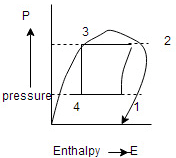This set of Refrigeration Multiple Choice Questions & Answers (MCQs) focuses on “Theoretical VCR with Wet Vapour after Compression”.
1. The COP of vapor compression when vapor is wet after compression having refrigeration effect (Re) of 60 and work done (W) of 20 is?
a) 3
b) 4
c) 4.2
d) 5
View Answer
Explanation: The COP is given by Refrigeration effect by work done,
COP=\(\frac{Re}{W}\)
= \(\frac{60}{20}\) = 3.0.
2. Which case is when the refrigerant compression process is carried while it’s wet?
a) Wet state
b) Dry state
c) Semi-dry state
d) Always
View Answer
Explanation: In case of wet state the vapor compression process remains in wet state i.e. for compression of refrigerant is carried out while it’s still wet and for dry state compression is done in dry state.
3. In case of reciprocating compressors, wet compression is avoided.
a) True
b) False
View Answer
Explanation: In case of reciprocating compressors, wet compression is avoided as the liquid droplets in the refrigerant would enter the compressor and damage the valves and other moving parts.
4. Which one of the following is not an assumption in theoretical vapour compression cycle?
a) There are no pressure losses in the condenser, evaporator, compressor, valves and the connecting part lines
b) All processes are reversible
c) There are mechanical and fluid friction losses
d) There is no heat transfer between the system and surroundings except in the evaporator and condenser
View Answer
Explanation: There are no mechanical or fluid friction losses, is one of the assumptions made in theoretical vapor compression cycle. The other assumptions are all processes are reversible, there is no heat transfer between the system and surroundings except in the evaporator and condenser and there are no pressure losses in the condenser, evaporator, compressor, valves and the connecting part lines.
5. Power consumption in dry compression is less than wet compression.
a) True
b) False
View Answer
Explanation: It is found that the power consumption is about 8%-10% less with wet compression compared to dry-compression. Hence power consumption in dry compression is less than wet compression.
6. Due to what in wet-compression affects the heat transfer rates from the vapor refrigerant to the cooling medium?
a) Liquid droplets
b) Work consumed
c) Power required
d) In wet-compression the heat transfer remains unaffected
View Answer
Explanation: In wet – compression the liquid droplets may carry the lubricating oil from the cylinder walls of the compressor. This oil would then pass into the condenser and adversely affect the heat transfer rates from the vapor refrigerant to the cooling medium.
7. The following p – h diagram indicates?

a) Vapor compression when vapor is dry at the end of the compression
b) Vapor compression when vapor is wet at the end of the compression
c) Vapor compression when vapor is dry – saturated at the end of the compression
d) Vapor compression when vapor is dry before of compression
View Answer
Explanation: As from the diagram we can see that the compression line does not touch the saturated line it means that the vapor after compression is wet. For dry compression, it should’ve touched the saturation line.
Sanfoundry Global Education & Learning Series – Refrigeration & Air Conditioning.
To practice all areas of Refrigeration & Air Conditioning, here is complete set of 1000+ Multiple Choice Questions and Answers.
If you find a mistake in question / option / answer, kindly take a screenshot and email to [email protected]
- Apply for Mechanical Engineering Internship
- Check Refrigeration & Air Conditioning Books
- Practice Mechanical Engineering MCQs
- Check Mechanical Engineering Books
